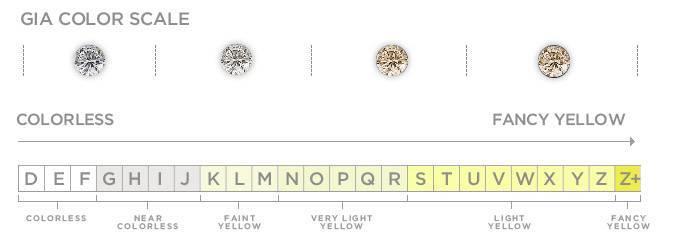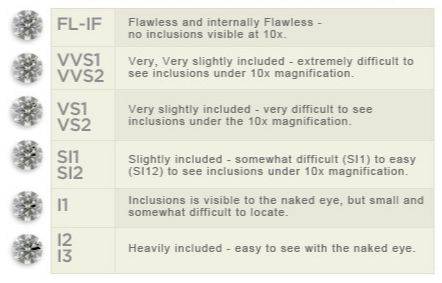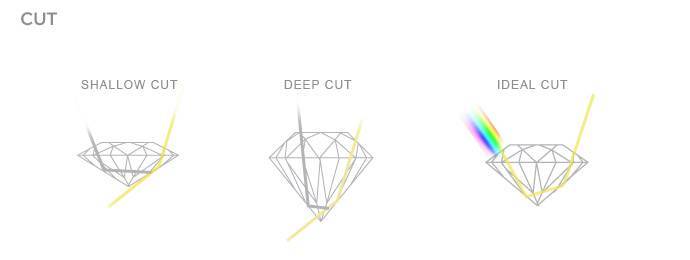LEARN ABOUT DIAMONDS
The 4C's - Color, Clarity, Cut & Carat Weight
Color

- In diamonds, color actually refers to a lack of color, usually tints of yellow or brown. The less color the diamond has, the more rare it is. Minute traces of other elements, present at the time the diamond was formed, are the cause of color in most diamonds.
- Differences in color are measured using the internationally accepted GIA color scale which assigns a color grade starting at the letter “D” and progressing through the alphabet all the way to the letter “Z”. The further away from “D” the diamond is, the more tint of color the diamond contains. Many times the variance in color is so slight it can only be detected by a trained grader, in the proper environment, comparing the diamond against a master set of diamonds.
Clarity

- Diamonds were formed deep within the earth millions of years ago. Sometimes while the diamond is growing, gasses or other elements will become trapped inside the crystal forming what are known as “inclusions.” Inclusions are a diamond's birthmark. They are most reliable way of identifying a diamond because no two diamonds have the exact same inclusion in the exact same spot. They're like the diamond's fingerprint.
- The smaller and more difficult the inclusions are to see, the higher the diamond will rate on the Clarity scale. It's important to keep in mind however, that high clarity doesn't necessarily equal more sparkle. That's affected mostly by cut, which we'll explain next.
Cut

SHALLOW CUT - When the diamond is cut too shallow, light passes straight through it, reducing the sparkle.
DEEP CUT - When the diamond is cut overly deep, light gets trapped inside and eventually leaks out the bottom and sides of the stone, causing it to appear dark.
IDEAL CUT - Modern concepts of the Ideal cut have shifted away from Tolkowski's original calculations to include any set of parameters for a 58 facet round diamond that returns maximum light through the crown or top of the diamond. Many variations fit the modern definition of Ideal, offering optimal or near-optimal light performance.
FIRE & ICE CUT - Fire and Ice represents the latest innovation in the science of diamond cutting design, consistently returning maximum light, producing superior brilliance while maintaining a larger diamond diameter.
Carat Weight

Most people think of carat weight as the size of the diamond when it is actually the weight of the diamond. The word “carat” comes from the carob seed, a product of the Locust tree. These seeds are so precise and uniform in weight that they were used by early gem and diamond traders as the standard unit of measurement. One carat is equal to 200 milligrams or 1/142 of an ouce. Carat sizes are also expressed in fractions of a carat or “points,” with each point equaling 1/100 of a carat. For example; a one carat diamond weighs 100 points, a 3/4 carat diamond 75 points, a 1/4 carat diamond 25 points and so on.
A diamond weighing one carat is exceptionally rare. Hundreds of tons of rock and ore must be mined and processed in order to recover a single one carat gem-quality diamond. For this reason, diamond prices tend to increase exponentially with weight. In other words, a one carat diamond is not twice as expensive as a 1/2 carat diamond… it's three times as much, everything else being equal.
Weight does not necessarily equal physical size either. Proportions can have a dramatic effect on the dimensions of a diamond. Two diamonds of the same carat weight may appear to be different sizes depending on how the diamond is cut. Many diamonds have extra weight added to the bottom of the stone causing them to appear smaller than a properly cut diamond.